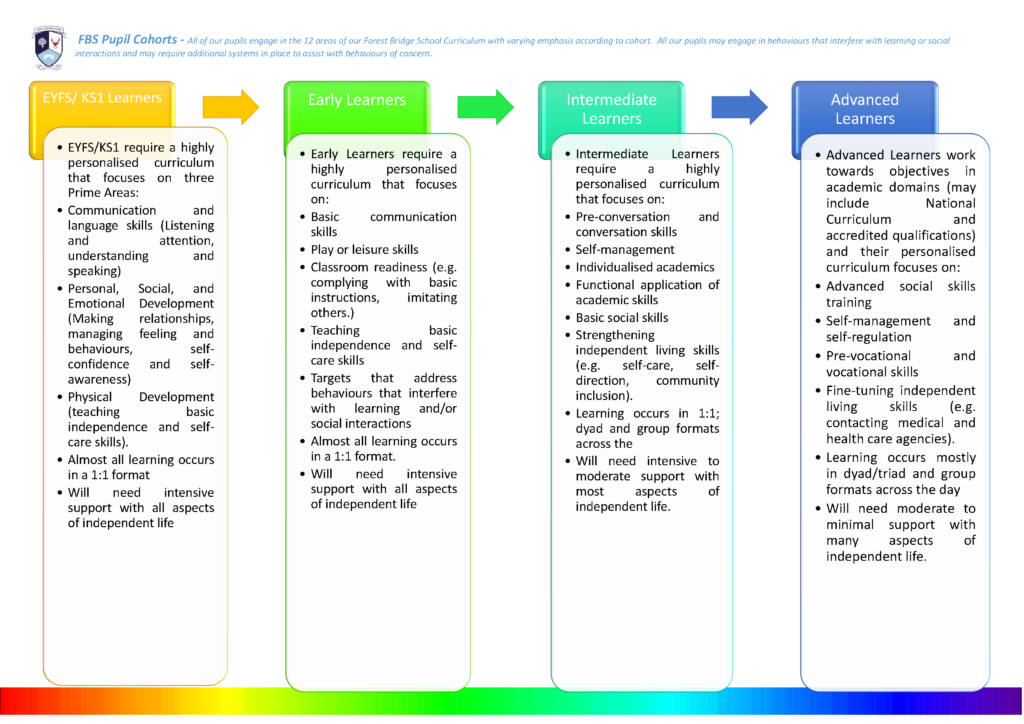Curriculum
The Forest Bridge School Curriculum (FBSC) is designed specifically with our learners’ primary diagnosis of Autism in mind, with the overarching, long-term outcome to prepare each learner for adulthood. This has been achieved through a collective, multi-disciplinary process between school staff, including teachers, aba supervisors, speech and language therapists, occupational therapists, psychotherapists, governors, parent founders of the school, the local community and our learners.
Curriculum Intent
The FBSC is underpinned by our whole school values of Respect, Achievement, Resilience and Enjoyment and emphasis on the following:
- Curriculum for Children with a primary diagnosis of Autism
- Highly personalisedCurriculumCmfor each learner,
- Preparing each learner for adulthood.
As highlighted in the areas above, we also have a 3-fold commitment towards our;
- Pupils– to provide them with a respectful curriculum that helps them to achieve resilience and enjoyment through the process
- Staff (including all therapies in school) – to utilise the FBSC to its full potential to ensure the school values.
- Community (including parents/families) – to play an active role in informing the curriculum outcomes and planning, leading to the best possible community involvement
Preparing for adulthood and life after school is what we are all working towards for our pupils. The assesment and Curriculum provided by this model support the individual as they make transitions into, through and out of school at the level they require. The individual learning journey of each child is decided by their progress instead of being juxtaposed to peers or age-related benchmarks.
The curriculum is holistic at its core, and the assessment tool has been developed with education experts, BCBAs, Speech & Language Therapists, Occupational Therapists, service users, parents and school governors.
In matters of layout, the Forest Bridge School curriculum is divided into 12 domains: Independent Living, Employment (Pre-requisites), Employment (Functional), Community inclusion, Health and wellbeing, Communication, Social Skills, STEAM (i.e. Science, Technology, Engineering, Arts and Math), Academics Literacy, Academics Maths, Academics Science, and Academics ICT.
Those domains are, in turn, grouped into three larger groups: Stand Alone Academics (includes: Academics Literacy, Academics Maths, Academics Science, and Academics ICT domains), Social Communication & STEAM (includes: Communication, Social Skills and STEAM domains) and Preparation for Adulthood (includes: Independent Living, Employment Pre-requisites/Functional, Community Inclusion and Health and Wellbeing domWellbeingch of the domains includes a series of outcomes, Personalised Learning Objectives (PLO) that grow progressively more complex. Starting PLOs function as pre-requisite skills for further growth within that particular domain, and the last PLOs function as the culmination of all the skills acquired (for example: in Academic Literacy, the first PLO is To Show Interest In Books, and the last PLO is To Be Able To Compare Writers’ Ideas And Perspectives Across Two Or More Texts).
Phonics and Early Reading
We use the Read Write Inc program for teaching phonics and early reading.
For detailed information, please see our FBSC Handbook.
FBS Cohorts
